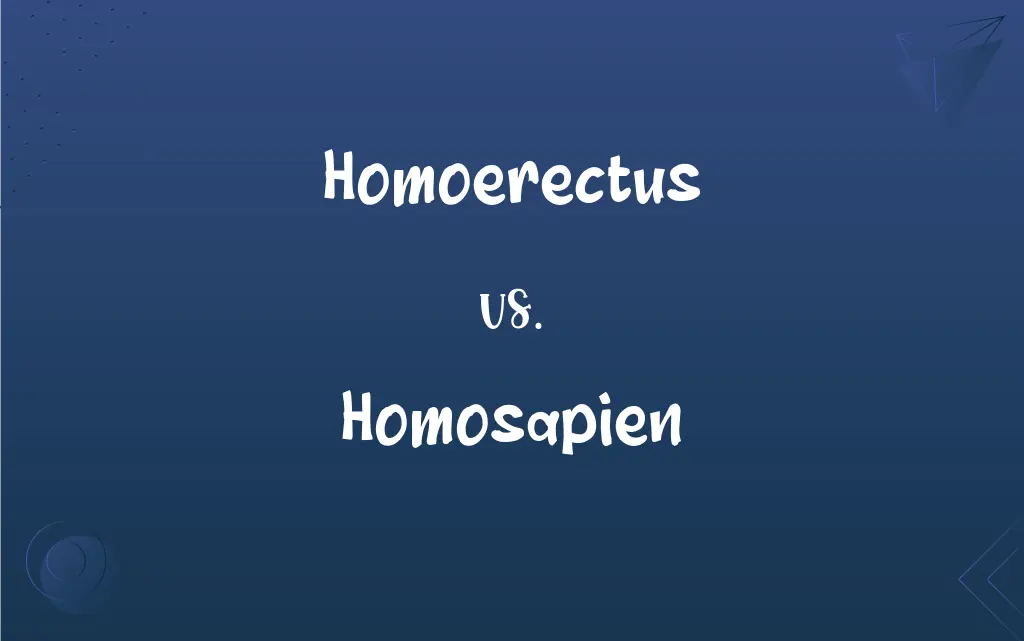Homoerectus vs. Homosapien: What's the Difference?
Edited by Aimie Carlson || By Harlon Moss || Published on November 29, 2024
Homo erectus were early humans with simpler tools and brain size, while Homo sapiens, modern humans, have advanced tools and larger brains.

Key Differences
Homo erectus, an early human species, emerged about 2 million years ago, known for their upright walking ability. In contrast, Homo sapiens, our own species, appeared around 300,000 years ago, characterized by a more complex brain and sophisticated language.
The physical build of Homo erectus was robust and adapted for endurance, with a larger body and thicker skull bones. Homo sapiens, however, evolved with a lighter skeleton, a rounder skull, and a more pronounced chin, reflecting significant evolutionary changes.
In terms of tool use, Homo erectus made rudimentary tools primarily for cutting and scraping, indicating the beginning of tool innovation. Homo sapiens developed a wider range of tools, including needles and spears, showcasing advanced cognitive skills.
Homo erectus had a smaller brain compared to Homo sapiens. This difference implies a significant leap in cognitive abilities, with Homo sapiens capable of abstract thinking, planning, and complex social structures.
Socially, Homo erectus likely had basic forms of communication, but their language capabilities were limited. Homo sapiens, on the other hand, developed complex languages, enabling intricate social interactions and the transmission of culture.
ADVERTISEMENT
Comparison Chart
Time Period
Emerged 2 million years ago
Appeared around 300,000 years ago
Physical Characteristics
Robust build, thicker skull
Lighter skeleton, rounder skull, pronounced chin
Brain Size
Smaller brain
Larger, more complex brain
Tool Use
Rudimentary tools for cutting, scraping
Advanced tools, including needles, spears
Language and Society
Basic communication, limited language
Complex languages, intricate social structures
ADVERTISEMENT
Homoerectus and Homosapien Definitions
Homoerectus
An early human species known for upright walking.
The discovery of Homo erectus fossils in Africa shed light on human evolution.
Homosapien
Possess a larger brain and more sophisticated language skills than their ancestors.
The language of Homo sapiens facilitated the development of complex societies.
Homoerectus
Existed for over a million years, showing remarkable evolutionary success.
The long existence of Homo erectus underscores their adaptability and resilience.
Homosapien
Have the ability to adapt and manipulate environments extensively.
Homo sapiens have transformed landscapes to suit their needs, from cities to farmlands.
Homoerectus
Known for using simple stone tools.
Homo erectus' stone tools represent the dawn of human ingenuity.
Homosapien
Capable of abstract thinking and planning for the future.
Homo sapiens’ ability to plan led to agriculture and civilization.
Homoerectus
Lived in Africa, Europe, and Asia, showing wide dispersal.
The widespread fossils of Homo erectus suggest they were one of the first humans to migrate extensively.
Homosapien
Modern humans, characterized by advanced cognitive abilities.
Homo sapiens developed art and culture, reflecting their complex thought processes.
Homoerectus
Homo erectus had a robust build and a smaller brain than modern humans.
The skeletal structure of Homo erectus indicates their adaptability to diverse environments.
Homosapien
Known for creating diverse and sophisticated tools.
The tools of Homo sapiens range from simple hand axes to intricate electronic devices.
FAQs
When did Homo erectus live?
About 2 million to around 100,000 years ago.
What tools did Homo erectus use?
Simple stone tools for cutting and scraping.
How did Homo sapiens evolve?
From earlier human species, developing advanced cognitive abilities.
What distinguishes Homo sapiens from Homo erectus?
Homo sapiens have a larger brain, complex language, and advanced tools.
How is Homo sapiens' social structure?
Complex, with intricate social interactions and organizations.
What are Homo sapiens known for?
Advanced tool-making, language, and culture.
What is Homo erectus?
An early human species known for upright walking and basic tool use.
What are the physical characteristics of Homo sapiens?
Lighter skeleton, rounder skull, and more pronounced chin.
Where was Homo erectus found?
In Africa, Asia, and Europe.
Did Homo erectus have language?
They likely had basic communication, but not complex language.
Did Homo erectus and Homo sapiens coexist?
There is evidence suggesting a brief overlap in their timelines.
What was the diet of Homo erectus?
Primarily meat and plants, indicative of hunter-gatherer behavior.
What role does language play in Homo sapiens' evolution?
It's crucial for complex social structures and cultural transmission.
Were Homo erectus skilled hunters?
Their tools suggest they were capable hunters and gatherers.
How do Homo sapiens adapt to environments?
Through technology, altering landscapes to meet their needs.
How have Homo sapiens impacted the earth?
Through extensive environmental modification and technological advancements.
What differentiates Homo sapiens' tool use from Homo erectus?
Homo sapiens' tools are more varied and sophisticated, reflecting higher cognitive skills.
How did Homo erectus adapt to their environment?
Through physical robustness and basic tool use.
What signifies Homo sapiens' cognitive abilities?
Art, planning, and abstract thinking demonstrate advanced cognition.
What is the significance of Homo erectus in human evolution?
They represent an important step in the development of human traits.
About Author
Written by
Harlon MossHarlon is a seasoned quality moderator and accomplished content writer for Difference Wiki. An alumnus of the prestigious University of California, he earned his degree in Computer Science. Leveraging his academic background, Harlon brings a meticulous and informed perspective to his work, ensuring content accuracy and excellence.
Edited by
Aimie CarlsonAimie Carlson, holding a master's degree in English literature, is a fervent English language enthusiast. She lends her writing talents to Difference Wiki, a prominent website that specializes in comparisons, offering readers insightful analyses that both captivate and inform.






































































